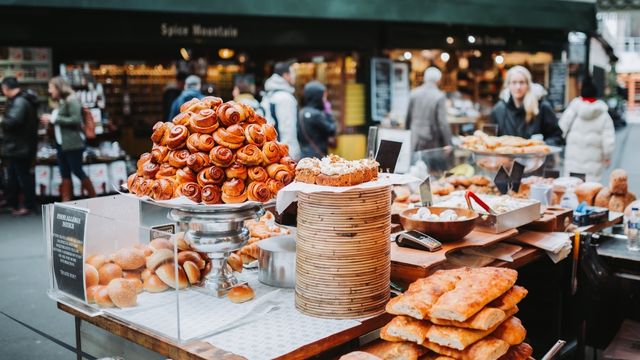London’s food scene never sits still for long. One year it’s all about charcoal croissants and rainbow bagels, the next it’s plant-based tasting menus and ramen pop-ups. But 2025 has felt a little different — not just about fleeting fads, but genuine shifts in how Londoners eat, drink, and think about food. From green tea powders taking over cafés to chefs redefining “British” with global flavours, here’s what’s been cooking across the capital this year.
Matcha Mania: The Green Revolution
Matcha used to be that mysterious green drink only hardcore tea lovers or yoga teachers ordered. Fast forward to 2025, and it’s everywhere. Walk into almost any café in Shoreditch or Notting Hill, and you’ll spot someone sipping a frothy, jade-coloured latte that looks suspiciously good on Instagram.
But it’s not just about the aesthetics. Londoners are becoming more health-aware and caffeine-conscious, swapping their afternoon flat whites for something a little more mellow but still energising. Matcha — made from finely ground green tea leaves — ticks all the boxes: it’s smooth, earthy, packed with antioxidants, and just different enough to feel like a treat.
Even big coffee chains have caught on, rolling out iced matcha drinks in every size imaginable. Independent cafés are experimenting too — from matcha lemonades and sparkling sodas to matcha croissants and desserts. It’s official: matcha has moved from niche to mainstream, and Londoners are loving it.
Hojicha Takes the Stage
Of course, where matcha goes, its roasted cousin isn’t far behind. Hojicha, made from roasted green tea leaves, is having its moment too. It’s the darker, toastier sibling — with a comforting caramel-like aroma and a naturally low caffeine kick. Perfect for late afternoons or anyone who wants something soothing that still feels special.
In 2025, hojicha powder has become the go-to alternative for those who find matcha a little too grassy. London cafés are blending it into lattes, ice creams, and even cocktails. The flavour is subtle but addictive — nutty, earthy, and surprisingly versatile. There’s something very “London” about it too: understated, comforting, and a bit niche, but in the best way possible.
You can now find hojicha drinks from Kensington tea houses to Dalston coffee bars, and they’re proving that the roasted tea trend is more than just a sidekick to matcha. It’s the next big wave in the capital’s ever-evolving drink scene.
Plant-Based Goes Prime Time
London’s plant-based food movement has matured beautifully. What used to be a side salad or a token vegan burger is now the star of the show. In 2025, the focus isn’t on “vegan” as a label — it’s on great flavour. Think mushroom shawarmas dripping with tahini, miso aubergine with a silky glaze, and jackfruit tacos that could fool any carnivore.
This year has seen a big rise in restaurants that are entirely plant-focused but not in a preachy way. They’re fun, creative, and full of personality. Chefs are pulling inspiration from every corner of the globe — Middle Eastern spices, Korean sauces, Japanese broths — proving that vegetables aren’t boring; they’re just misunderstood.
And it’s not just in restaurants. Food markets, street vendors, and even traditional pubs are offering impressive meat-free options. The plant-based trend isn’t a diet anymore — it’s part of everyday London eating.
Global Fusion, the London Way
Fusion food is nothing new here, but in 2025 it’s hit a whole new level. The difference? It’s more authentic, less forced. London’s chefs are embracing their heritage and mixing it with the city’s multicultural energy in genuinely creative ways.
It’s now completely normal to see West African jollof paired with Korean-style pickles, or a Sunday roast reimagined with miso gravy and tempura veg. Street food festivals have become melting pots of ideas — each stall trying to outdo the next with flavour, fun, and flair.
This kind of cooking sums up modern London perfectly: confident, curious, and always ready to experiment. The old “rules” about what belongs together are long gone, and diners are all for it.
Drinks, Snacks, and the Rise of the “Experience”
Beyond meals, the way Londoners drink and snack has shifted too. People are chasing experiences as much as flavours. It’s not just about grabbing a latte anymore — it’s about finding the café that makes a “better” one, whether that means ceremonial matcha whisked the proper way or a hojicha latte topped with oat foam and sesame syrup.
Even the drink menus are turning into adventures. Non-alcoholic “elixirs” with adaptogens and natural energy boosters are popping up everywhere. Kombucha taps, nitro teas, matcha spritzers — you name it. It’s all part of this bigger movement towards mindful indulgence: things that make you feel good without the guilt.
Snacking has levelled up too. Gone are the days of a boring flapjack. Londoners now graze on small-batch cookies, Asian-inspired mochi doughnuts, and matcha-infused chocolates. There’s an appreciation for craftsmanship, even in the little things.
The Bigger Picture
If there’s one thing all these trends share, it’s that Londoners are craving connection — to their food, their city, and the cultures that shape it. The capital’s food scene in 2025 feels less about showing off and more about sharing stories, traditions, and creativity.
Matcha and hojicha have become symbols of that change: traditional Japanese ingredients reimagined in a London context, bridging East and West one sip at a time. They’re not trends in isolation — they’re part of a broader evolution where London’s culinary culture feels more global, inclusive, and personal than ever.
In short, 2025 has proven that London’s appetite for discovery is stronger than ever. Whether it’s sipping on a perfectly whisked matcha latte, trying your first hojicha affogato, or tucking into a vegan Sunday roast, one thing’s clear — the city’s food scene isn’t just thriving, it’s redefining what “modern British” means, one delicious experiment at a time.
